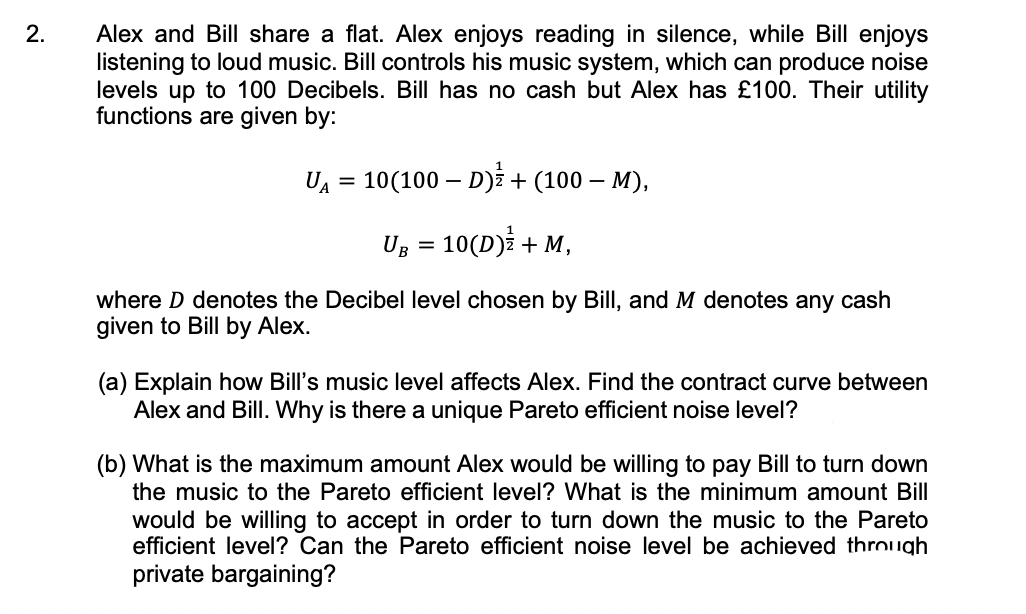Alex and Bill share a flat. Alex enjoys reading in silence, while Bill enjoys listening to loud music. Bill controls his music system, which can produce noise levels up to 100 Decibels. Bill has no cash but Alex has £100. Their utility functions are given by: 2. UA = 10(100 – D)i + (100 – M), %3D Uz = 10(D) + M, where D denotes the Decibel level chosen by Bill, and M denotes any cash given to Bill by Alex. (a) Explain how Bill's music level affects Alex. Find the contract curve between Alex and Bill. Why is there a unique Pareto efficient noise level? (b) What is the maximum amount Alex would be willing to pay Bill to turn down the music to the Pareto efficient level? What is the minimum amount Bill would be willing to accept in order to turn down the music to the Pareto efficient level? Can the Pareto efficient noise level be achieved through private bargaining?
Alex and Bill share a flat. Alex enjoys reading in silence, while Bill enjoys listening to loud music. Bill controls his music system, which can produce noise levels up to 100 Decibels. Bill has no cash but Alex has £100. Their utility functions are given by: 2. UA = 10(100 – D)i + (100 – M), %3D Uz = 10(D) + M, where D denotes the Decibel level chosen by Bill, and M denotes any cash given to Bill by Alex. (a) Explain how Bill's music level affects Alex. Find the contract curve between Alex and Bill. Why is there a unique Pareto efficient noise level? (b) What is the maximum amount Alex would be willing to pay Bill to turn down the music to the Pareto efficient level? What is the minimum amount Bill would be willing to accept in order to turn down the music to the Pareto efficient level? Can the Pareto efficient noise level be achieved through private bargaining?
Chapter7: Uncertainty
Section: Chapter Questions
Problem 7.8P
Related questions
Question

Transcribed Image Text:2.
Alex and Bill share a flat. Alex enjoys reading in silence, while Bill enjoys
listening to loud music. Bill controls his music system, which can produce noise
levels up to 100 Decibels. Bill has no cash but Alex has £100. Their utility
functions are given by:
UA = 10(100 – D)i + (100 – M),
%3D
Ug = 10(D)i + M,
where D denotes the Decibel level chosen by Bill, and M denotes any cash
given to Bill by Alex.
(a) Explain how Bill's music level affects Alex. Find the contract curve between
Alex and Bill. Why is there a unique Pareto efficient noise level?
(b) What is the maximum amount Alex would be willing to pay Bill to turn down
the music to the Pareto efficient level? What is the minimum amount Bill
would be willing to accept in order to turn down the music to the Pareto
efficient level? Can the Pareto efficient noise level be achieved through
private bargaining?
Expert Solution
This question has been solved!
Explore an expertly crafted, step-by-step solution for a thorough understanding of key concepts.
Step by step
Solved in 3 steps

Knowledge Booster
Learn more about
Need a deep-dive on the concept behind this application? Look no further. Learn more about this topic, economics and related others by exploring similar questions and additional content below.Recommended textbooks for you

